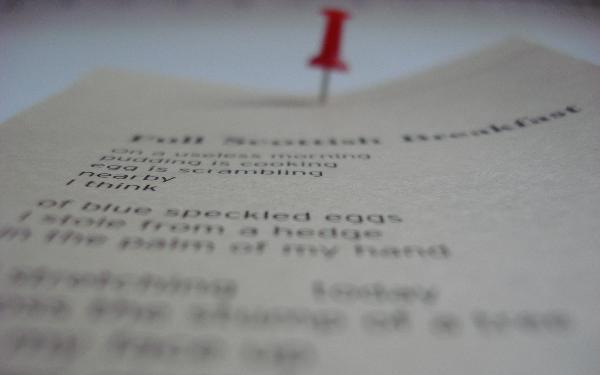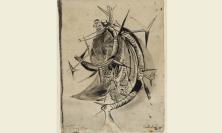On 21 March each year, we celebrate a literary form that has a tendency to divide its readership. This World Poetry Day, Nathan Koblintz invites us to read works by two celebrated poets, Gerard Manley Hopkins SJ and Emily Dickinson. In letting their poems speak to us about faith, can we understand how poetry can be a way of leading us closer to God?
At some point in every literature student’s career, you are handed two poems and invited to wrestle with those old beasts, Compare and Contrast. They stand guard over a cave in which we are promised some kind of revelation awaits discovery. You take the two poems and make the approach. Proximity unmasks the guardians: they are not monsters, they are bureaucrats who insist you swamp your heart with abstractions, couch your enthusiasm in unsatisfactory similes, and what we usually find behind them is an unsatisfactory essay about rhyme schemes, structure and the poet’s ‘use of language’. As a teacher I have had many students turn around once the fight is done and ask, ‘But what’s the point?’ World Poetry Day invites us to ask that same question: what is the value of poetry?
The Catholic tradition offers us a very useful tool to approach this question. The practice of Lectio Divina demands that we slow down and listen to a text – very different to our normal process of reading, when our main concern is to absorb the information as rapidly as possible and move on. The first stage of Lectio Divina is about spending time with words, listening rather than hunting for meaning. It is impossible to do this in a classroom or examination hall with poetry, and this is one of the reasons why many of us have never had a relationship with a poem: our first experience is having to ‘do’ a poem in a forty-minute class, with fast-tracked insight and analysis rewarded.[1]
Two years ago I wrote that poetry of any ilk can be of value to people of faith in the attention it draws to the significance of every fleck of life. This World Poetry Day I want to share the experience of linking two poems explicitly concerned with faith. Poetry does three things: it records; it communicates; and it creates a new thing in the world. In all three activities it can lead us closer to God.
*
Emily Dickinson and Gerard Manley Hopkins SJ never met and they almost certainly never read one another’s poems. The second half of the 19th century found them writing poetry in different countries in small rooms: Dickinson in the upstairs bedroom of her family home in Massachusetts, and Hopkins in the Jesuit communities at St. Beuno’s in Wales and then at Mount Street in London. Both were odd, private individuals, whose poems were little read in their lifetimes. I am connecting these two poets through poems that were both written whilst the poet was in their early thirties (Dickinson wrote hers at 31; Hopkins at 33).
Here are the two poems[2]:
God’s Grandeur
The world is charged with the grandeur of God.
It will flame out, like shining from shook foil;
It gathers to a greatness, like the ooze of oil
Crushed. Why do men then now not reck his rod?
Generations have trod, have trod, have trod;
And all is seared with trade; bleared, smeared with toil;
And wears man’s smudge and shares man’s smell: the soil
Is bare now, nor can foot feel, being shod.
And for all this, nature is never spent;
There lives the dearest freshness deep down things;
And though the last lights off the black West went
Oh, morning, at the brown brink eastward, springs—
Because the Holy Ghost over the bent
World broods with warm breast and with ah! bright wings.
Gerard Manley Hopkins SJ (1877)
This world is not conclusion;
A sequel stands beyond,
Invisible, as music,
But positive, as sound.
It beckons and it baffles;
Philosophies don’t know,
And through a riddle, at the last,
Sagacity must go.
To guess it puzzles scholars;
To gain it, men have shown
Contempt of generations,
And crucifixion known.
(Emily Dickinson, likely composed 1862, pub. 1924)
For this comparison it is worth including eight lines from a later version of Dickinson’s poem[3], that continue the poem as follows:
Faith slips – and laughs, and rallies –
Blushes, if any see –
Plucks at a twig of Evidence –
And asks a Vane, the way –
Much Gesture, from the Pulpit –
Strong Hallelujahs roll –
Narcotics cannot still the Tooth
That nibbles at the soul –
(first published 1960)
‘The world’ / ‘This World’
We begin with statements of intent:
The world is charged with the grandeur of God.
This world is not conclusion.
Flags in the sand: this is what I am going to tell you about the world. But we cannot put both poems exactly on the same coordinates: Hopkins gives us the world; Dickinson, this world.
Hopkins opens like a brilliant speaker standing at the pulpit. His meaning is clear and our attention is hooked immediately. Look at that word ‘charged’. It contains a trinity of meanings: the world is electrified by the grandeur of God[4]; the world is challenged (or even accused) by the grandeur of God; and the world is stormed or overcome by the grandeur of God. There is no need to choose one meaning; all fit and co-exist. The word itself is charged with meaning. The images that follow in the next three lines – God’s grandeur like fire, like light shining off a sword, swelling like compressed oil – are variations on that first statement.
If Hopkins opens up with a major chord then Dickinson speaks in a disruptive whisper. Our ears prick – did she just say ‘This world’? It interrupts whatever we are doing. This world presses in on us in so many ways: you could be hurrying to a meeting, or caught up in the adrenaline of sport, or half way through an important conversation; all your attention focused in the moment. And then in your ear comes a whisper: ‘This world is not conclusion’. The effect is destabilising. The world shimmers and becomes less real, the word ‘this’ implying a reality beyond the one in which we are caught up.
These two types of speech, the sermon and the whisper, determine the route that the poems now take.
The Questions
Dickinson leaves us at the end of that first line with questions: if not this world, then which world is conclusion? What does conclusion mean? Paradoxes answer us: invisible as music, but positive as sound; beckoning but baffling; the puzzle of scholars. The rational mind tries to find meanings (in what way is sound positive?) but can only run into a wall of opacity. It is when we read this:
And through a riddle, at the last,
Sagacity, must go.
that Dickinson shows us how to read the poem. Those paradoxes are riddles, but not ones that can be solved by logic and knowledge. We are teased with meaning, only to have it turn away from us. The poem mirrors the experience of the divine that she is communicating: flashes of revelation and understanding, clouds of complexity and unknowing.
Hopkins’ question is the preacher’s rhetorical reproach:
Why do men then now not reck his rod?
If the world is so clearly infused with God, why do we not obey him? Generations have gone by, knowing that the world they live in is God’s creation, and yet the consequence seems to be pollution and damage: seared, bleared, smudge and smell. We are in the midst of a classic sermon: the grand opening, full of glory; then the challenge to the congregation.
Here we have two poems communicating in two clearly different ways. They relate to their meaning in a manner appropriate to their form: the sermon presents its meaning with the force of clarity; the riddle veils its meaning, obscuration and revelation dancing around it. It is the difference between the full beam of a spotlight and a candle flame covered and then uncovered by coloured veils.
Sound and the sense
I hope you have had the chance to read these two poems aloud. Poetry differs from prose in the importance it places on the noises made by the words. In English poetry, the two most commonly used aural qualities of words are rhyme (primarily in the combination of similar vowel sounds) and rhythm (the pattern of the naturally occurring mix of differently stressed syllables in every word).[5] The sound that the poem makes as it is being read aloud is a key part of its experience and there is no better poet to learn this from than Hopkins. Reading his poems aloud is like walking through a jungle. Sounds clamber over each other, dripping from line to line; surprises lurk around corners. The force of this can be felt in the final three lines of the first part of his poem:
And all is seared with trade; bleared, smeared with toil;
And wears man’s smudge and shares man’s smell: the soil
Is bare now, nor can foot feel, being shod.
The repetition of the ‘sm’ sound, which happens five times in two lines, transmits disgust more forcefully than the content alone can. We could paraphrase these lines so that only the meaning remains. If Hopkins had written ‘industrial trade and progress is damaging our countryside; the soil is barren and both animals and men are becoming separate from their environment’, he would be open to the accusation of being the caricature of the cloistered cleric, privileged in his separation from the world of work – this sickly 5’2” Oxford graduate pontificating about industry! In terms of content, this is the weakest moment in the poem: it has slipped into exaggeration (the soil is not actually bare). What saves it from failure is the momentum of emotion built up by the sound of the previous lines.
Dickinson does not need to do the same: there is no risk of her over-reaching herself with rhetoric or emotion. Instead she puts the sound of her poem to use by making it an insistent presence in your mind. Its rhythms are the same as a hymn and its rhyme scheme separates the poem up into verses: the second and fourth lines of each four-line unit rhyme or half-rhyme, and each verse is a self-contained unit of sense. Her poem – like so many of her poems – is very easy to memorise. Read her poem out loud as naturally as you would any piece of prose, pausing where the punctuation invites you to, and listen carefully to what emerges. That repeated rhythm leads each time towards the rhymed words. It is designed to slip into your memory and sit at the back of your mind.
Experiencing the sound of a poem reminds us that it is a physical creation that lives on the tongue and comes to us through the senses, not just the mind. This is the poem as a newly created thing in the world, an object that in the beginning was not there; once the poet’s work is done, there is a new thing under the sun.
Sunrise and narcotics
Let us return to the structure of Hopkins’ poem. I have presented it as a classic sermon: thesis (God’s grandeur is visible in the world); antithesis (man’s sin is visible in the world); and now the synthesis (the Holy Spirit protects us and the world from all evil). He has enlivened this argument in the drama of the poem and its language, creating a new thing as he writes: another object that is part of the world and hence shares in God’s grandeur.
The final four lines of the poems contain one of the best descriptions of a sunset and sunrise that I have come across:
And though the last lights off the black West went
Oh, morning, at the brown brink eastward, springs—
Because the Holy Ghost over the bent
World broods with warm breast and with ah! bright wings.
It is impressive for its compression of unusual sounds (particularly ‘black West went’ and ‘bent / World broods’) that give a freshness to those most tired of ‘poetic’ subjects, and for the accuracy of his language. To choose one word for our attention: ‘bent’. Like ‘charged’, the word is compacted with meaning, this time a double meaning: the world is bent in the way that man deforms it from its God-given direction; and it is bent in that it is curved. If you are ever on an aeroplane at sunrise look to the east and you will see the curvature of the earth; Hopkins saw this in his mind’s eye half a century before flight. But not only this: watch a sunset and you will see the breast of the sky begin to warm and colour before the sun rises, and Hopkins’ exhalation ‘ah!’ captures that moment when the crown of the sun first appears. Reading those four lines we experience words acting out a sunset and sunrise. At the same time we are reminded of the sunrises and sunsets we have seen, so we experience both our memories and the poem’s unique solar rediscovery concurrently. His poem elevates what could have been a clichéd pun (the sun rises; God’s son also rises for us) and infuses the physical world, and the poem’s word world, with God’s grandeur.
The ‘Strong Hallelujahs’ that roll at the end of Dickinson’s poem might well be echoing over from the finale to ‘God’s Grandeur’. But her poem is positioned to the side of this grand scene. That little word ‘Much’ (‘Much Gesture, from the Pulpit’) is spoken with wry observation. She sees the preacher’s hands and arms raised, waving about, with confidence in his own words; but that is all there is, much gesturing towards the divine. The poem has built up a litany of insistent uncertainty: there is a world beyond this one, but our conception of it is flawed, our reason too weak to understand it, our faith flickering. That world compels us even as it eludes our comprehension:
Narcotics cannot still the Tooth
That nibbles at the Soul –
This is extraordinary. To grasp just how unlikely an ending to the poem this is, imagine you had been set the following exercise: before you read the poem for the first time, you cover up the final two lines, read it through and then complete the poem with what you think Dickinson would have written. You know that the last line will rhyme with ‘roll’, that the two lines will have between 6-8 syllables each. You can even be given the final word ‘Soul’ to work towards, but I doubt that anyone would ever come up with the lines that Dickinson does. ‘Narcotics’ comes out of nowhere – it is a word from another universe, from the laboratory or the drugstore, not from a riddle about faith. There is a huge disconnect between the loud Hallelujahs of the congregation and this statement about a tooth nibbling at your soul: a disconcerting, unnerving image. It serves to irritate our self-satisfaction and undermine our worldly certainties. The poem, like the tooth, nibbles at us. Hopkins communicates the certainty of faith in the language of bright glory; Dickinson communicates the mystery of faith in language that resists our full comprehension.
*
Both poems are records of the irresistible. One is whispered, the other preached; tooth and sunset, riddle and sermon. Placed side by side the two poems feed off one another, wrestle and pair over meanings that are hinged together, then diverge and follow their own logic. It is in this dialogue between two compatible but significantly different creations that we see their value emerging. Both are true statements about the world, this world we live in: that it is at once filled and overbrimming with God’s grandeur, looked over and protected by the Holy Spirit; and it is also temporary, transient, a ghost of a world, behind which an ungraspable certainty calls us. Poetry can handle these kinds of contradictory truths in a way that no other medium can. Its truths are not the truths of dogma or of science, where deviation means falsehood. In fact its multiple truths are a response to the multiplicity of creation and the inexhaustible nature of God.
I have argued that a poem does three things: records, communicates and creates. This third aspect is the one that as people of faith we should relish immediately. It is the root of poetry’s superfluity. Debates in our society about the value of something usually centre on either utilitarianism or hedonism as the deciding principle: something is valuable if it is useful or if it causes pleasure. This is why there is such mild consternation about the value of poetry: it clearly is not useful in the way that medicine is useful; and it can be too hard to be pleasurable, in the way that television is pleasurable. But as Christians we already take delight in the superfluous. Our lives – terminal, filled with frustrated plans and equivocal loves – are pointless both in utilitarian and hedonistic terms. We are superfluous, unless we have been created simply to participate in God’s creation. These two poems are both new creations that have been added to the store of things in the world. There is never any need for poetry; and there is never enough poetry. It is created like we are, out of joy in the act of creating.
What is the point of poetry? There is not a one-line answer to take to its critics, nor will there be a teleological revelation awaiting its disciples. These two poems offer insight and truths, and they are also, in their unnecessary existence, signs of abundance. Entering into a relationship with a poem through a slow and loving reading is point and value enough.
Nathan Koblintz is a former member of the Thinking Faith editorial board.
[1] Forced memorization of poems through rote-learning may have been a joyless exercise, but the benefit was that it allows a poem to take up long term residence in your mind. Current techniques for teaching poetry make it a lot more approachable, but still has yet to find the right balance between fun and depth.
[2] The textual history of Dickinson’s poems is complicated. She published only seven poems in her lifetime (out of a total of 1775) and the remainder have been published posthumously with variations in both content and punctuation (her ubiquitous hyphens being “normalized” into commas, semi-colons and colons in the early editions) by several different editors. The version here comes from the 1924 publication of her poems by her niece; the final two verses are quoted from T.H. Johnson’s 1960 version of the poem, which retains the punctuation of her manuscript.
[3] From Emily Dickinson: The Complete Poems, edited by Thomas H. Johnson (London: Faber & Faber, 1975)
[4] Hopkins was a keen observer of the physical world and it is likely that he would have been familiar with at least the basics of electrostatic theory – Michael Faraday’s experiments with electrical charges in the first half of the 19th century were well known.
[5] Prosody, the classical study of metre, rhythm and form in poetry, has a lot to answer for. Every word is rhythmic in that each syllable is emphasized with varying force: poets align words so that they create a particular rhythm. When this rhythm becomes regular and repeated, it is called a metre. It is as simple as that. Prosody extends into the classroom through phrases like ‘iambic pentameter’, ‘trochees’, ‘feminine endings’, but it’s very hard to teach this other than in a kind of trainspotting style (‘this one is in iambs, this one in dactyls’ – but so what?). The problem is that the metrical patterns that we are taught to spot in English poetry have been lifted from ancient Greek poetry, a language with foreign patterns of stress, and the desire for categorisation comes from a very different era of education. Too often the terms serve to obscure rather than elucidate the nature of poetry.
![]() Secular Psalms: Faith and Contemporary Poetry by Nathan Koblintz
Secular Psalms: Faith and Contemporary Poetry by Nathan Koblintz






